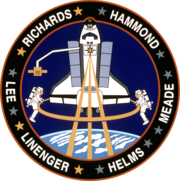STS-64
| STS-64 | |||||
 | |||||
| Uppdrag | 64 | ||||
|---|---|---|---|---|---|
| Rymdfärja | Discovery (19)[1] | ||||
| NSSDC-ID | 1994-059A[2] | ||||
| Färdens tid | 10 dagar, 22 timmar, 49 minuter, 57 sekunder | ||||
| Uppskjutning | |||||
| Startplats | Startplatta 39B vid Kennedy Space Center i Florida | ||||
| Start | 9 september 1994, 6:22:35pm EDT | ||||
| Landning | |||||
| Landningsplats | Runway 4, Edwards AFB, California | ||||
| Landning | 20 september, 1994, 5:12:52pm EDT | ||||
| Omloppsbana | |||||
| Varv | 174 st[3] | ||||
| Apogeum | 269 km | ||||
| Perigeum | 259 km | ||||
| Banlutning | 56,9° | ||||
| Sträcka | 7,242 miljoner km | ||||
| Rymdpromenad | |||||
| Antal | 1 st | ||||
| Total tid | 6 timmar, 51 minuter | ||||
| Besättning | |||||
| Befälhavare | Richard N. Richards (4) | ||||
| Pilot | L. Blaine Hammond (2) | ||||
| Uppdragsspecialister | Jerry M. Linenger (1) Susan J. Helms (2) Carl J. Meade (3) Mark C. Lee (3) | ||||
 | |||||
| Kronologi Rymdfärjeprogrammet | |||||
| |||||
STS-64 var en flygning i det amerikanska rymdfärjeprogrammet med rymdfärjan Discovery. Den sköts upp från Pad 39B vid Kennedy Space Center i Florida den 9 september 1994. Efter nästan elva dagar i omloppsbana runt jorden återinträdde rymdfärjan i jordens atmosfär och landade vid Edwards Air Force Base i Kalifornien.
Besättning
Se även
Referenser
- ^ NASA Space Shuttle Launch Archive Arkiverad 20 mars 2009 hämtat från the Wayback Machine., läst 28 juli 2016.
- ^ ”NASA Space Science Data Coordinated Archive” (på engelska). NASA. https://nssdc.gsfc.nasa.gov/nmc/spacecraft/display.action?id=1994-059A. Läst 20 mars 2020.
- ^ Manned Astronautics - Figures & Facts Arkiverad 17 oktober 2013 hämtat från the Wayback Machine., läst 28 juli 2016.
Externa länkar
 Wikimedia Commons har media som rör STS-64.
Wikimedia Commons har media som rör STS-64.
| ||||||||
| ||||||||||||||||||||||||||||||||
Media som används på denna webbplats
Författare/Upphovsman: Pascal (Flickr user: pasukaru76), Licens: CC0
Vostok spacecraft replica at the Technik Museum Speyer, Germany.
STS-64 Crew
- The crew assigned to the STS-64 mission included Richard N. Richards, commander (center front); L. Blaine Hammond Jr., pilot (front left); and Susan J. Helms, mission specialist (front right). On the back row, from left to right, are Mark C. Lee, Jerry M. Linenger, and Carl J. Meade, all mission specialists. Launched aboard the Space Shuttle Discovery on September 9, 1994 at 6:22:55 pm (EDT), the STS-64 mission marked the first flight of the Lidar In-Space Technology Experiment (LITE) and the first untethered Extravehicular Activity (EVA) in ten years.
STS-65 Mission Insignia
STS-64 Mission Insignia
STS-68 Mission Insignia






